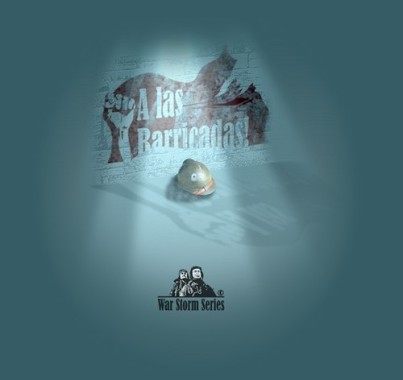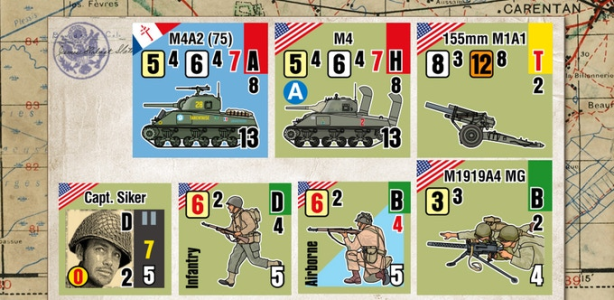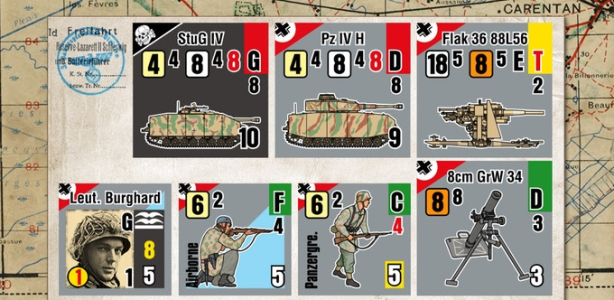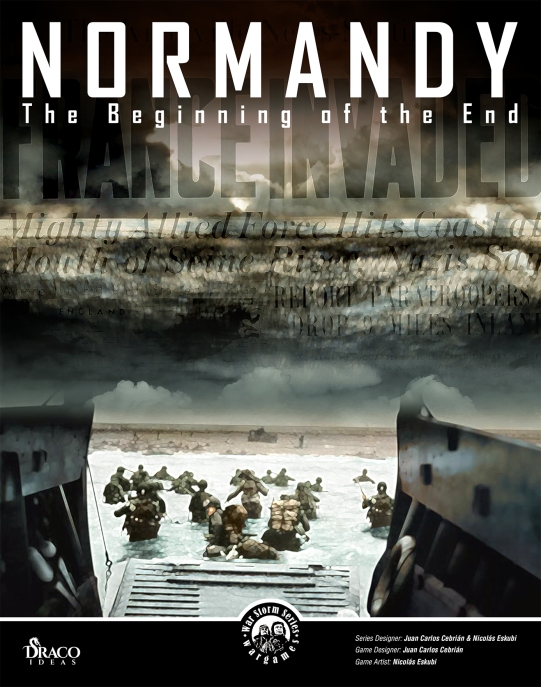Normandy: The Beginning of the End is a tactical war game and the fourth installment of the renowned War Storm Series (WSS) saga, in which players lead their troops through scenarios that take place on the Western Front of World War II from the early days of the D-Day landings until August 1944. Normandy: The Beginning of the End is currently on Kickstarter and funded in 4 days. I have been following the game since it was teased last year and was excited when I reached out to one of the designers Nicolás Eskubi and he agreed to do this interview. If you are interested in the Kickstarter, please follow this link to the page: https://www.kickstarter.com/projects/dracoideas/normandy-the-beginning-of-the-end
We also were able to do an interview with Nicolás last year to talk about his work as a Wargame Graphic Artist. He is very talented and that ability definitely shows in the high quality components in this offering.

Nicolás, how does it feel to have such a huge project as Normandy: The Beginning of the the End at the finish line and on Kickstarter?
Nicolás: Its a big responsibility and I am glad we are almost there. We know about the wargaming community’s expectations about this subject and title and we won’t let the gamers down. We also need to keep the same quality of our previous titles in this series, while we bring some new gaming experiences.
What were the challenges you experienced with the design?
Nicolás: To insert fresh air into the game while simultaneously maintaining compatibility with previous WSS titles. We rearranged the design of counters, as an example, without substantially altering them, so any War Storm Series owner will feel comfortable in front of the new board at the table.
Why did you feel the desire to do a game on an Operation as large as Operation and important as Operation Overlord?
Nicolás: It was a milestone in World War II and it left us memories of incredible valor on both sides of conflict. We thought that it was a “must-do” to make a game for the War Storm Series based on D-Day. It just wouldn’t seem complete without a game on this operation. Furthermore, I personally am a huge Stephen E. Ambrose fan, and the Band of Brothers television series too!
 Grant: How did you come to team up with your design partner Juan Carlos Cebrián?
Grant: How did you come to team up with your design partner Juan Carlos Cebrián?
Nicolás: We met each other at an internet forum. We live in different cities, but soon friendship arose, and our affinity for wargames drove both of us to design A las Barricadas!, about the Spanish Civil War in the 1930s, which is a conflict very close to us both as Spaniards.
Grant: What expertise does Juan Carlos bring to the project?
Nicolás: Juan Carlos has over 40 years of experience as a wargamer and is the co-founder of the oldest wargame club in Spain. Furthermore, he worked in the beginning of the Alea and Líder magazines, two reference publications on wargames in the Spanish community. He knows a lot about wargames.
Grant: What is the scale of the game and how did you focus on this during design?
Nicolás: We decided to make a platoon scale game, so I know that we chose an uncommon scale used in the design of wargames so far. It allows interesting options at a tactical level. It keeps length, map size and counter number to a very manageable size yet allows for the feeling of the impact and grand scale of the battle.
Grant: I understand the game uses a system of simultaneous actions called “WE GO”, which is a turn-based and real–time hybrid where players will alternate the activation of units. Why did you make the decision to use this alternating impulse system?
Nicolás: Its simply a way to shorten the play time of one player while the other player thinks about his upcoming turn. It is a very friendly system for gamers that keeps things moving. We also think it reflects the constant changing conditions of the battlefield, “No plan survives enemy contact” as von Moltke said.
Our “WE GO” activation system forces the players to plan strategically, but to react tactically to their rival’s movement.
Grant: What advantage does this give the design as far as playability?
Nicolás: It brings dynamic play to the table, with less waiting time and a lot of surprises. A player begins their turn with a planned movement, based on the general situation shown on the board. When the other player activates though and takes his action, he is forced to rearrange plans on the fly, because the enemy won’t collaborate in your plans nor do what it was that you expected always!
Grant: I know that the War Storm Series relies on command and Officers are the keystone of the game. How did you design the role of Officers?
Nicolás: Officers lead the soldiers on the battlefield. Their orders encourage them beyond their limits by granting bonuses. Thus, they not only activate all platoons at same time as the officer, but also they’ll need him to command in key moments or in difficult tasks like, for example, walking through a line of barbed wire.

Grant: How can their absence affect a player?
Nicolás: To activate the platoons out of command, you need to check every platoon’s morale. If they don’t pass the check, the platoon won’t do anything this turn.
Also, an Officer loss has an overwhelming effect on company morale. There are replacement officers that will take the lead quickly, but with lower attributes.
Grant: As you mentioned, I understand that troop morale is paramount in the design and reflects battle in a more realistic way. How do you accomplish this in the design and how does it work?
Nicolás: A soldier, in the clamor of battle, is not that perfect slaughter machine with a total lack of feeling. They are simply human beings that rely on their mental strength and on their unit’s cohesion to perform dangerous tasks, overcoming their fears in a hostile environment such as a battlefield. Low morale troops won’t perform well with difficult tasks.
Every Company as a single entity, has its own morale value, based on its training, experience, parent unit, commanding Officer, etc.
Companies and platoons, during the game, will have to check morale under certain circumstances to not be forced to flee the field of battle. Morale checks must be performed when the unit suffers casualties after an assault involving tanks, or to perform risky tasks, such as crossing a line of barbed wire, for example.
Grant: I see that the game is played on a set of modular isomorphic maps, which may be lined up by any of its edges. Why did you make the decision to go this route over more traditional maps?

Nicolás: The isomorphic maps offer a lot of possibilities for creating individual scenarios, considering the fact that Normandy uses a point driven system to design your own battles, using maps from other War Storm Series titles, increasing exponentially both replayability and value of each game of our saga.
Grant: The counters look gorgeous and I love the silhouettes of the units used in full color. How do these counters affect the overall game play experience?

Nicolás: The counter’s general purpose is to mark position and status of the unit in-game and provide all the needed data for them to function, shown in an efficient and easy to read way.
A nicer looking design, doesn’t only fulfill this function, but it also makes the experience way better for the players by immersing them in the battle.
Grant: What different scenarios are available?
Nicolás: The box comes with 13 scenarios, depicting a range of battles from June 5th to about three months after the invasion. Also, the size varies, from three companies in a single map to a full batallion using all four maps at once.

Grant: Are there other special scenarios that can be unlocked as stretch goals?
Nicolás: Yes, there are plenty available as stretch goals. Currently, Hauts Vents three linked scenarios, Mortain mini campaign, Saint Lô, and more yet to come!

Grant: What is your personal favorite scenario?
Nicolás: It’s like asking a dad which is his favorite son, I can’t reply. I love all of them!
Grant: You mentioned earlier that players can generate their own scenarios and play Normandy by using a point-based system that is detailed in the Exclusive Rules manual. How does this work?
Nicolás: In fact, players can design scenarios as they want. What we explain in the Exclusive rules is how to do it, and we recommend depending on what type of battle you want to create (meeting engagement or Attack and Defense) the developing mechanics, map choice, victory conditions, deployment and, at least, depending upon the size and type of scenario, the point quantity for each side for buying units varying upon quality (veterans, greens or regulars)
Grant: I’m interested in the Alone in the Storm solo system designed by José Manuel Moreno. What does this system add as far as modes?

Nicolás: This system not only adds new game modes as a solo system, cooperative mode (2 players vs. AI) and competitive modes (2 players vs. 2 players), it adds new fog of war rules. The multiplayer systems explore at the same time the cooperation and competition between players. You have to cooperate with your partner to defeat the AI (or other 2 human players), but you have to try to get more victory points and a lower amount of losses to beat him and be promoted.
Grant: What options does the system offer for difficulty and autonomy?
Nicolás: The system has been designed to offer 2 difficulty systems, although we still are evaluating the chance to add a 3rd one. Regarding autonomy, you can find a full AI that manages the enemy side using a priority list, dice rolling and tables, and flow charts. In this way, players don’t have to make any decisions for the AI side. However, all this management in a game system such as this one, which is open and you have a great amount of possibilities, can be a bit difficult. For that reason, and mainly due to some players lack of desire for a complete AI management and they prefer a lighter one, we have included a simplified solo system, that applies part of the solo rules and makes the solo game system easy to learn. For the simplified game, you have general rules for solo games, including AI side attitude or activation rules, but you have to switch sides to take some decisions.
Grant: Can Alone in the Storm be used with other War Storm Series titles?
Nicolás: Yes of course. In a game series like this one we think it makes no sense to develop a different set of solo rules for each game. Obviously, we had to work hard to make rules compatible with Republican/Nationalist improvised tanks or with Normandy’s German/US ones. We have developed a set of charts and tables that let you use Alone in the Storm with any previous published game. These compatibility tables shall be available in PDF to be downloaded.
Grant: What has been player player reaction to the solo system?
Nicolás: They are enthusiastic! Although the War Storm Series fits fine with changing sides of the table to solo mode, due to turn’s smoothness, when we talk about an autonomous decision making system, with an additional fog of war feature, they love it!
Grant: What are you most pleased with about the system?
Nicolás: I’m very pleased with the fog of war rules. And the solo mode adds a lot of uncertainty and luck. Each intelligence markers has probably that a company of the type shown on the counter (infantry, heavy weapons or tank) but when it is recognized an event is shown at its backside. This event may cause that more companies appear or the company found may be a different type than the expected ones…or you may even find…nothing except a wrong intelligence report!
For 4 player games, the intelligence markers provide the same uncertainty, but random events are not used. At first of the game players may purchase not only companies, they may purchase the events printed as the intelligence markers! Each player writes down in a player log sheet which events have been purchased and only once the enemy try to recognize your intelligence marker, it is revealed to your opponents! So you can try to cheat your enemies purchasing “fake” events for example.
Grant: What areas are you still tweaking with playtesting?
Nicolás: We still are working on the difficulty levels. We have to decide if the 3rd level is enough challenging for solo players.
Grant: What are the available stretch goals for the campaign?
Nicolás: We are going to include in the campaign the chance to get the compatibility charts printed in the game box. We expect to include one stretch goal for each previously published game.

Grant: When do you expect the game to be fulfilled?
Nicolás: We expect that we will send the files to the printer in June/July timeframe, which will allows for us to send finished games to backers in September.

Thanks to Nicolás for his time in answering our questions during this busy Kickstarter campaign. I meant to get this information out last month but the holidays snuck up on me and delayed my efforts. The game looks amazing, not only in its aesthetic components, but the game play looks interesting and I am excited to see how it plays differently than some of my other D-Day games. If you are interested in the Kickstarter, please follow this link to the page: https://www.kickstarter.com/projects/dracoideas/normandy-the-beginning-of-the-end
-Grant

Thank you for this interview. I own first two instalments in the WSS series – A las Barricadas! & La Bataille de France, 1940 (both Compass Games, 2015) – but never really grasp the playing mechanics of this system. I also found the (English) game rules somehow confusing. Probably, it is just me.
On the other hand, I was always interested in solo mode Alone In the Storm. Maybe I should give them another chance.
LikeLike
To this point, I have yet to play a WSS series game so I cannot speak to the rules or the mechanics. I wonder too if it is a translation issue. Thanks for reading our stuff.
LikeLike
Thank you playersaid for making me poorer. I joined the kickstarter on this one!
LikeLike
Poorer as to the things of the world but much richer in gaming and fun.
LikeLike